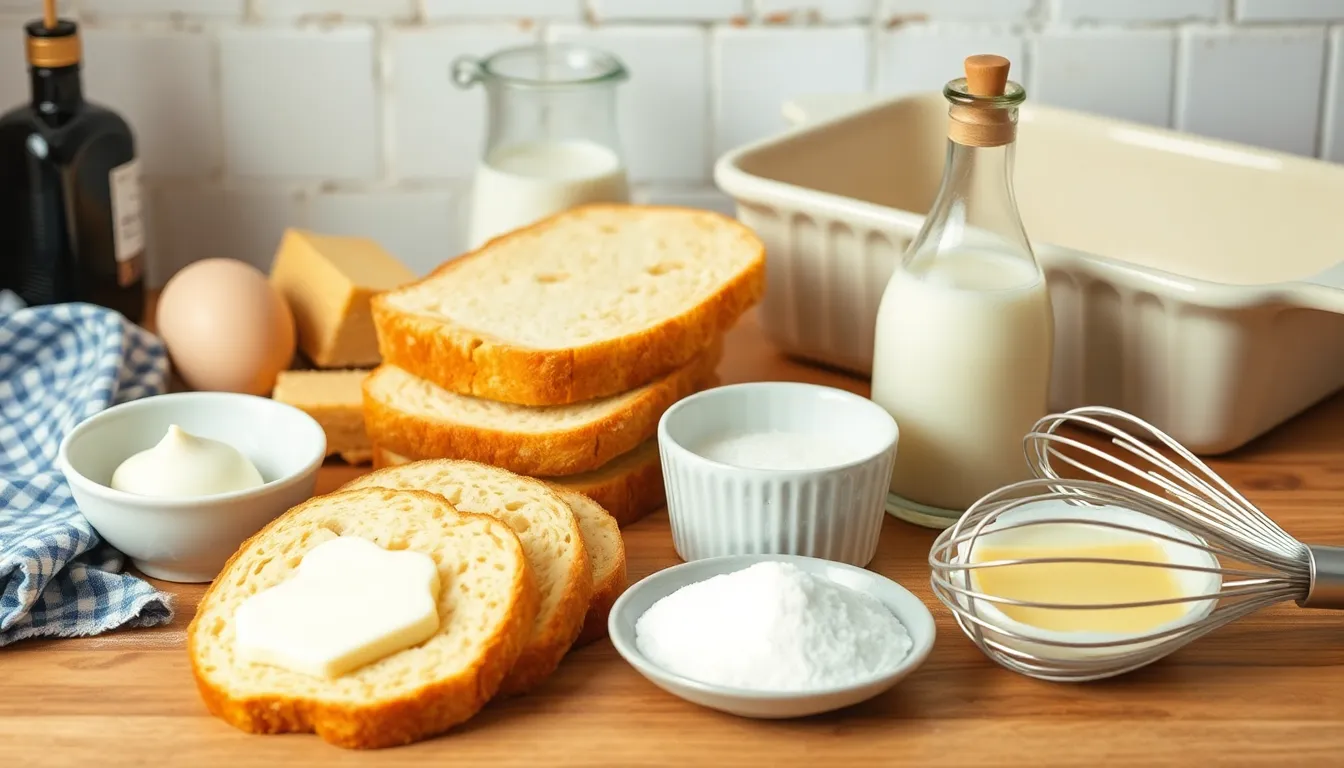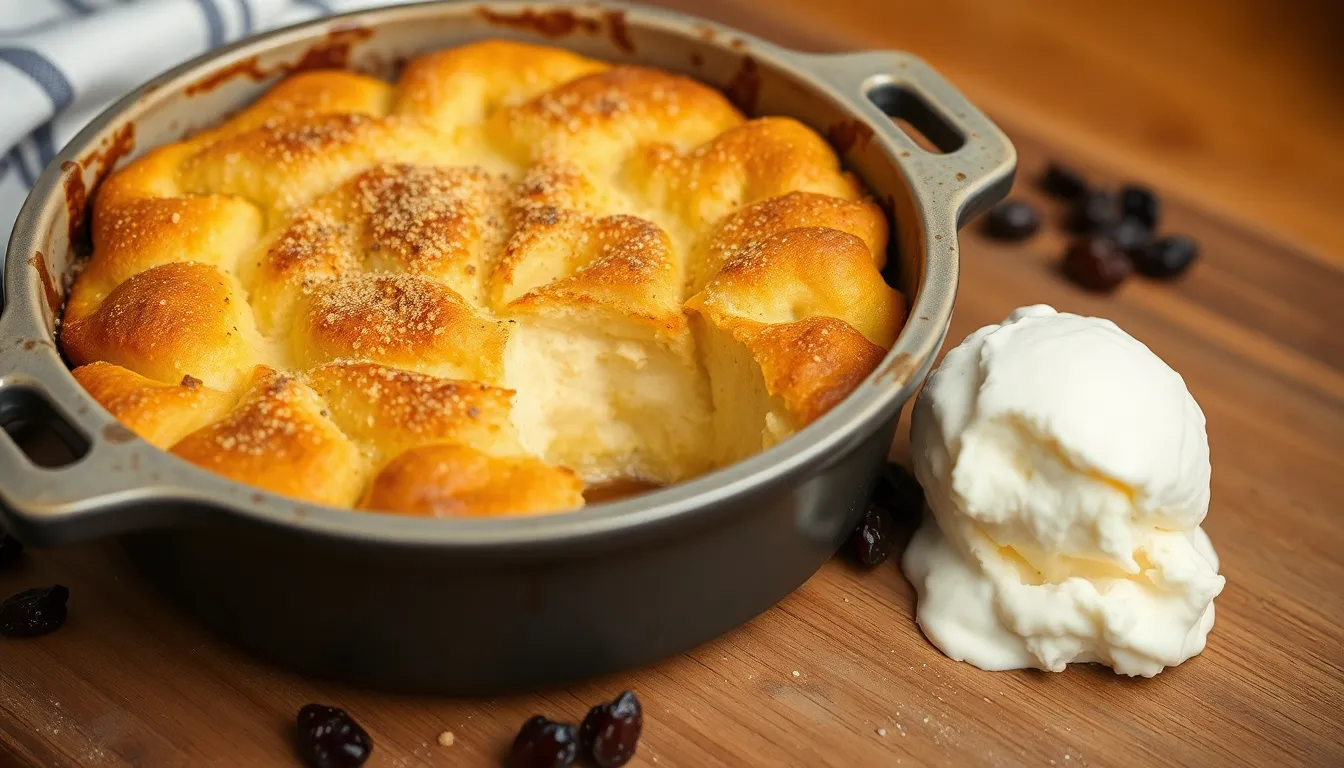Table of Contents
ToggleWhen it comes to comfort food, few dishes can compete with Mary Berry’s brioche bread and butter pudding. This delightful dessert transforms simple ingredients into a warm hug for the taste buds. Imagine buttery brioche soaked in creamy custard, baked to golden perfection, and topped with a sprinkle of nutmeg—it’s enough to make anyone weak in the knees.
Overview of Mary Berry’s Brioche Bread and Butter Pudding
Mary Berry’s brioche bread and butter pudding represents classic comfort food. The recipe highlights the use of buttery brioche, which elevates the dish with its rich flavor and soft texture. Creamy custard, infused with vanilla and eggs, adds depth and sweetness to the combination.
Baking the pudding leads to a golden, slightly crisp top while retaining a moist interior. Nutmeg sprinkled on top provides a subtle warmth that enhances the overall experience. Many find it perfect for family gatherings or casual dinners.
Preparation involves layering soft brioche slices with a buttery spread, often paired with dried fruits like raisins or currants. Pouring the custard mixture over the layers allows for complete absorption, ensuring every bite is flavorful.
Baking occurs in a preheated oven until the custard sets. The resulting dish emerges warm and fragrant, inviting everyone to indulge. Serving suggestions often include a scoop of vanilla ice cream or a drizzle of custard for added richness.
Recreating Mary Berry’s brioche bread and butter pudding proves to be both simple and satisfying. With easy-to-follow steps and accessible ingredients, it offers a delightful indulgence that warms the heart. This dish resonates with many, making it a beloved option in dessert menus.
Ingredients and Equipment Needed

Gathering the right ingredients and equipment ensures the success of Mary Berry’s brioche bread and butter pudding. Here’s a detailed look at what’s required.
Essential Ingredients
- Brioche bread provides a rich and buttery base, enhancing the pudding’s flavor.
- Unsalted butter adds moisture and helps create a luscious texture.
- Eggs contribute to the custard’s structure and richness.
- Milk combines with the cream for a smooth custard consistency.
- Heavy cream elevates the dish’s indulgence, giving it a luxurious mouthfeel.
- Granulated sugar sweetens the custard, balancing flavors perfectly.
- Vanilla extract infuses the pudding with warmth and depth.
- Dried fruits, like raisins or currants, add sweetness and a pleasant chew.
Recommended Equipment
- Baking dish holds the assembled pudding during baking.
- Mixing bowl combines the custard ingredients effortlessly.
- Whisk ensures the custard mixture is smooth and well-blended.
- Knife slices the brioche uniformly for even layering.
- Measuring cups and spoons provide precise ingredient quantities.
- Oven provides the necessary heat for baking the pudding to perfection.
- Cooling rack allows the pudding to cool slightly before serving, finishing it off beautifully.
Step-by-Step Instructions
This section provides clear steps for creating Mary Berry’s brioche bread and butter pudding, ensuring a delightful dessert experience.
Preparing the Brioche
Select fresh brioche bread for optimal texture. Slice the bread into thick pieces, about one inch each. Spread unsalted butter generously on both sides of every slice. If desired, incorporate dried fruits like raisins or currants between the layers. Allow the prepared brioche to sit briefly while the custard mixture is prepared, ensuring flavors meld together.
Assembling the Pudding
Combine eggs, granulated sugar, milk, and heavy cream in a mixing bowl. Whisk until fully blended, adding vanilla extract for richness. Layer the buttered brioche slices in a baking dish, slightly overlapping them for even absorption. Pour the custard mixture over the arranged brioche, ensuring every slice is thoroughly soaked. Let the assembled pudding rest for about 10 minutes, allowing the brioche to absorb the custard.
Baking the Pudding
Preheat the oven to 350°F (175°C) while waiting. Place the baking dish in the oven and bake for 35 to 40 minutes. Look for a golden-brown top with a slight puff, indicating doneness. If necessary, cover lightly with foil to prevent over-browning. Once finished, remove the pudding and allow it to cool for a few minutes before serving.
Tips and Tricks for Success
Selecting the right brioche bread is crucial. Opt for fresh, soft brioche for the best texture and flavor in the pudding. Layering techniques make a difference, so ensure even distribution of dried fruits like raisins or currants. Mixing the custard should incorporate air, resulting in a light and creamy consistency.
Allowing the brioche slices to soak in the custard is important for flavor absorption. Aim for at least 30 minutes of resting time, which enhances the overall taste. When preparing the custard, whisk eggs and sugar until fully combined before adding milk and cream. This ensures a smooth mixture without lumps.
Baking at the correct temperature matters. Set the oven to 350°F (175°C) to achieve an even bake. Keep an eye on the pudding; it’s ready when the top is golden brown and slightly puffed. Testing for doneness can be done with a skewer inserted into the center; it should come out clean.
Serving suggestions enhance the experience. Serve warm with a side of vanilla ice cream or a drizzle of custard. For added flavor, sprinkle nutmeg or cinnamon on top just before baking. Lastly, storing leftovers requires proper covering; wrap tightly and refrigerate to maintain freshness. Reheat in an oven for the best texture.
Variations and Customizations
Brioche bread and butter pudding offers ample opportunity for variations. One popular option involves incorporating chocolate, where adding dark or milk chocolate chips creates a rich flavor contrast.
Another variation integrates seasonal fruits like berries or apples, providing a fresh twist on the traditional recipe. Cinnamon can elevate the experience, introducing warmth and spice to the custard mixture.
For those seeking a richer texture, a splash of flavored liqueur such as Grand Marnier or Amaretto can enhance the custard’s complexity. Using different types of bread, including challah or croissants, yields delightful results and unique flavors.
Taste preferences often dictate the addition of spices or zest. Orange zest or lemon zest brightens the dessert, contributing a refreshing note. Substituting honey or maple syrup for sugar sweetens the pudding in a different way, providing various flavor profiles.
Serving styles can also differ. Some enjoy the pudding with a drizzle of warm custard, while others prefer a scoop of freshly whipped cream or crème fraîche on top. Garnishing with toasted nuts adds both flavor and texture, making each serving more appealing.
Customization extends to presentation, as portion sizes can range from individual ramekins to a large baking dish, depending on the occasion. Making mini puddings can offer a delightful single-serving option at gatherings.
Exploring these variations allows for personal touches that enhance the classic brioche bread and butter pudding experience. Each customization invites creativity while preserving the dish’s comforting essence.
Conclusion
Mary Berry’s brioche bread and butter pudding stands as a timeless dessert that captures the essence of comfort food. Its rich flavors and soft texture make it a perfect choice for any occasion. With the ability to customize ingredients and presentation, this pudding invites creativity while maintaining its classic charm. Whether served warm with ice cream or enjoyed on its own, it promises a delightful experience for all. Embracing the simple yet indulgent nature of this dish ensures it remains a favorite in kitchens everywhere.



